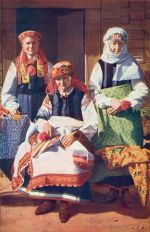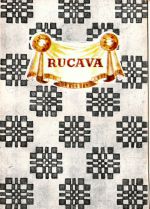The cover's background shows a traditional weave pattern; inside are illustrations detailing:
- krekla shēma — blouse schematic
- apakles un aproces raksts — collar and cuff embroidered pattern
- ņieburs — bodice
- sakta — brooch, here the large brooch worn at the elbow, pinning shawls together
- uzpleca raksts — embroidered pattern on top of the shoulder
- kniepķens — blouse brooch — two studs fastened side by side with hanging charms
- kaspine — a feature of Kurzeme (Courland) women's folk costumes: a colorful silk ribbon worn around the head and braided with the hair
The flip side provides brief overviews in French, English, Russian, and Latvian.
Rucava
Rucava is the south-western-most parish of Latvia, along the Baltic coast, also the name of the town which is its administrative center (earlier also known as Paurupe). Rucava first appears in historical documents in 1253, when the Courish kingdom of Duvzare was divided between the Courland bishopric and the German Sword Brethren, the agreement signed by Bishop Heinrich I of Lützelburg and Sword Brethren representative Eberhard von Sayn. Rucava is named "Rutzowe" in both German and Latin versions of the agreement.
Present-day Rucava parish is made up of three baronial manors (in German): Gut Kakischken, Gut Meirischken, and Gut Rutzau. Pursuant to a Latvian-Lithuanian border commission decision, the village of Būtiņģe (Būtingė) and Palanga (same now in Lithuanian) parish were joined to Lithuania. Numerous changes were made to the territory of the parish during the Soviet era.
The Paurupe area developed as a craftsperson and merchant free hamlet, and by the measures of the day was already a notable settlement by the beginning of the 17th century. The Rucava Lutheran Church, built 1872–1874, is a national architectural monument.1
Rucava folk costume

Rucava parish, like the Nīca and Bārta parishes, is small, yet its folk costumes are very characteristic and unlike those of surrounding parishes. In the place of wearing the traditional crown of woven flowers, girls wear a so-called kapsine, silk ribbons adorned with various ornaments, flowers, and leaves. Before donning the kapsine, hair was braided up into "horns" on each side of the head, kapsines applied around them, and pinned together at the nape of the neck. The women's fabric headcovering was the nāmats. Women also braided their hair into "horns". Once the nāmats was tied on, the entire head was covered, showing only the face. Short-fringed shawls (sagšas) were worn, covered in turn by a folded-over villaine (large shoulder kerchief), the resulting three layers pinned together with collection of brooches (saktas). The sagša was worn over the shoulder, with the brooches gathered at the right elbow. Blouses were white with colorful embroidery usually at the shoulders. The blouse was closed with one or more small brooches — not with a customary round brooch at the neck but a double-studded amber brooch with hanging charms. To give more body to skirts, cording was sewn into the hem. The bodice (ņieburs) was sewn from the same material as the skirt. Bodices were adorned with silver and gold brocade ribbons and red lacing. Socks were knitted plain white, or patterned.
| 1 | Adapted from Latvian Wikipedia |
 Gallery
Gallery


















